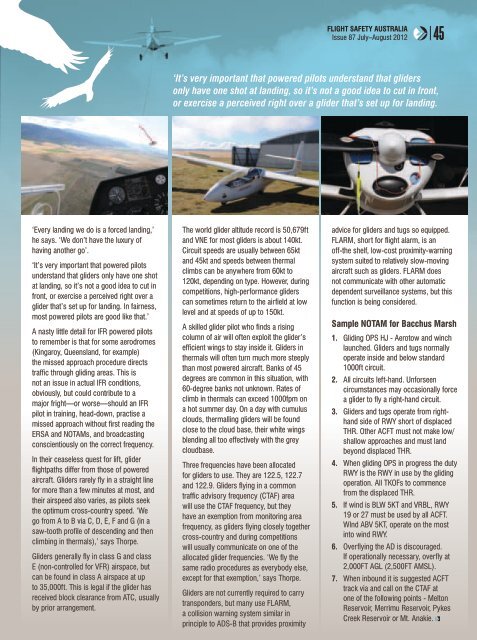jul-aug2012
You also want an ePaper? Increase the reach of your titles
YUMPU automatically turns print PDFs into web optimized ePapers that Google loves.
Flight Safety Australia<br />
Issue 87 July–August 2012<br />
45<br />
‘It’s very important that powered pilots understand that gliders<br />
only have one shot at landing, so it’s not a good idea to cut in front,<br />
or exercise a perceived right over a glider that’s set up for landing.<br />
‘Every landing we do is a forced landing,’<br />
he says. ‘We don’t have the luxury of<br />
having another go’.<br />
‘It’s very important that powered pilots<br />
understand that gliders only have one shot<br />
at landing, so it’s not a good idea to cut in<br />
front, or exercise a perceived right over a<br />
glider that’s set up for landing. In fairness,<br />
most powered pilots are good like that.’<br />
A nasty little detail for IFR powered pilots<br />
to remember is that for some aerodromes<br />
(Kingaroy, Queensland, for example)<br />
the missed approach procedure directs<br />
traffic through gliding areas. This is<br />
not an issue in actual IFR conditions,<br />
obviously, but could contribute to a<br />
major fright—or worse—should an IFR<br />
pilot in training, head-down, practise a<br />
missed approach without first reading the<br />
ERSA and NOTAMs, and broadcasting<br />
conscientiously on the correct frequency.<br />
In their ceaseless quest for lift, glider<br />
flightpaths differ from those of powered<br />
aircraft. Gliders rarely fly in a straight line<br />
for more than a few minutes at most, and<br />
their airspeed also varies, as pilots seek<br />
the optimum cross-country speed. ‘We<br />
go from A to B via C, D, E, F and G (in a<br />
saw-tooth profile of descending and then<br />
climbing in thermals),’ says Thorpe.<br />
Gliders generally fly in class G and class<br />
E (non-controlled for VFR) airspace, but<br />
can be found in class A airspace at up<br />
to 35,000ft. This is legal if the glider has<br />
received block clearance from ATC, usually<br />
by prior arrangement.<br />
The world glider altitude record is 50,679ft<br />
and VNE for most gliders is about 140kt.<br />
Circuit speeds are usually between 65kt<br />
and 45kt and speeds between thermal<br />
climbs can be anywhere from 60kt to<br />
120kt, depending on type. However, during<br />
competitions, high-performance gliders<br />
can sometimes return to the airfield at low<br />
level and at speeds of up to 150kt.<br />
A skilled glider pilot who finds a rising<br />
column of air will often exploit the glider’s<br />
efficient wings to stay inside it. Gliders in<br />
thermals will often turn much more steeply<br />
than most powered aircraft. Banks of 45<br />
degrees are common in this situation, with<br />
60-degree banks not unknown. Rates of<br />
climb in thermals can exceed 1000fpm on<br />
a hot summer day. On a day with cumulus<br />
clouds, thermalling gliders will be found<br />
close to the cloud base, their white wings<br />
blending all too effectively with the grey<br />
cloudbase.<br />
Three frequencies have been allocated<br />
for gliders to use. They are 122.5, 122.7<br />
and 122.9. Gliders flying in a common<br />
traffic advisory frequency (CTAF) area<br />
will use the CTAF frequency, but they<br />
have an exemption from monitoring area<br />
frequency, as gliders flying closely together<br />
cross-country and during competitions<br />
will usually communicate on one of the<br />
allocated glider frequencies. ‘We fly the<br />
same radio procedures as everybody else,<br />
except for that exemption,’ says Thorpe.<br />
Gliders are not currently required to carry<br />
transponders, but many use FLARM,<br />
a collision warning system similar in<br />
principle to ADS-B that provides proximity<br />
advice for gliders and tugs so equipped.<br />
FLARM, short for flight alarm, is an<br />
off-the shelf, low-cost proximity-warning<br />
system suited to relatively slow-moving<br />
aircraft such as gliders. FLARM does<br />
not communicate with other automatic<br />
dependent surveillance systems, but this<br />
function is being considered.<br />
Sample NOTAM for Bacchus Marsh<br />
1. Gliding OPS HJ - Aerotow and winch<br />
launched. Gliders and tugs normally<br />
operate inside and below standard<br />
1000ft circuit.<br />
2. All circuits left-hand. Unforseen<br />
circumstances may occasionally force<br />
a glider to fly a right-hand circuit.<br />
3. Gliders and tugs operate from righthand<br />
side of RWY short of displaced<br />
THR. Other ACFT must not make low/<br />
shallow approaches and must land<br />
beyond displaced THR.<br />
4. When gliding OPS in progress the duty<br />
RWY is the RWY in use by the gliding<br />
operation. All TKOFs to commence<br />
from the displaced THR.<br />
5. If wind is BLW 5KT and VRBL, RWY<br />
19 or 27 must be used by all ACFT.<br />
WInd ABV 5KT, operate on the most<br />
into wind RWY.<br />
6. Overflying the AD is discouraged.<br />
If operationally necessary, overfly at<br />
2,000FT AGL (2,500FT AMSL).<br />
7. When inbound it is suggested ACFT<br />
track via and call on the CTAF at<br />
one of the following points - Melton<br />
Reservoir, Merrimu Reservoir, Pykes<br />
Creek Reservoir or Mt. Anakie.

















